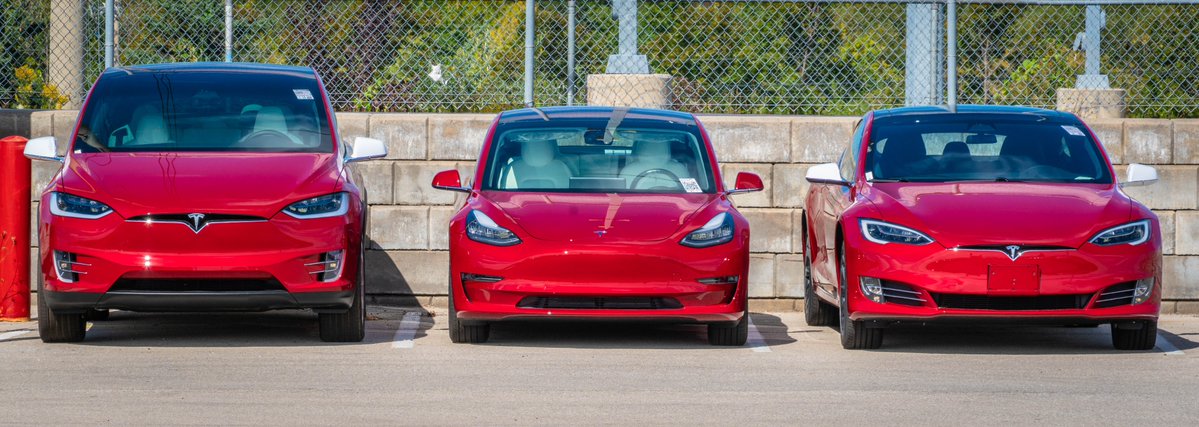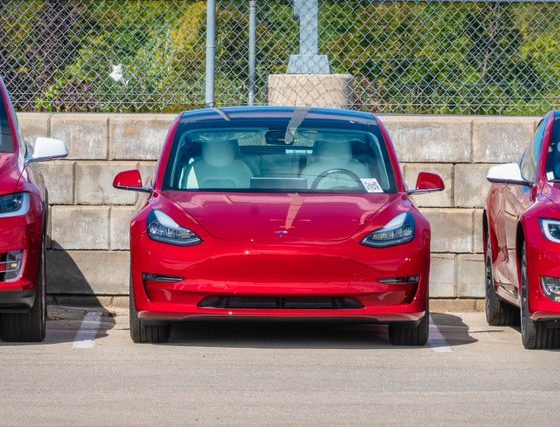

News
Tesla’ new Referral Program rewards allows owners to send photos to deep space
Starting October 5, Tesla customers who encourage their friends and family to purchase Model S, Model X, Model 3 and solar products using their referral code are set to receive a new set of perks. While Free Unlimited Supercharging has really been retired, Tesla’s new Referral Program rewards include some cool rewards, including one which involves Elon Musk’s other venture, SpaceX.
Tesla’s $100 Supercharging Credit, which the company introduced when it initially retired the Free Unlimited Supercharging program, now applies to every purchase of a new Model S, Model X, or Model 3. Unlike Free Unlimited Supercharging, which only applied to the Model 3 Performance, the $100 Supercharging Credit seems to apply for all Model 3 purchases regardless of trim level.
Perhaps most notable, though, is “Launch Your Photo into Deep Space Orbit,” a new reward for owners with one qualifying referral. The cool, fun perk involves Tesla laser-etching any photo of the owner’s choice that would be sent into deep space. Tesla did not state it explicitly on its new Referral Program page, but the laser-etched photos would most definitely be sent to orbit using rockets from Elon Musk’s private space company, SpaceX. Owners who wish to send their pictures to deep space orbit can expect a reminder on their Tesla mobile app to upload their selected photo sometime in December 2018.
Tesla owners with four qualifying referrals would also be given priority access to vehicle software updates. The company notes that once owners become eligible for this award, their vehicles will automatically receive software updates once available. Tesla owners who own more than one vehicle would see all of their electric cars get priority access to software updates, provided that the vehicles are associated with the same award-eligible Tesla Account.
Here is Tesla’s new Referral Rewards, effective October 5 – December 10, 2018.
1 Qualifying Referral:
Launch Your Photo into Deep Space Orbit – We’ll laser-etch any image onto glass and send it into deep space orbit for millions of years. Refer more friends while you wait for an alien race to discover your payload.
2 Qualifying Referrals:
Owners can choose either of the options below for each of their second referral.
Signature Black Wall Connector – This matte black Wall Connector is exclusive to the Referral Program and includes an etch of Elon’s signature.
Founders Series Tesla Model S for Kids – Share the Tesla experience of this miniature drivable electric Model S – including working headlights, a sound system and a charge port, just like yours. You can configure the Model S for Kids to keep or donate it to a local children’s charity.
3 Qualifying Referrals:
Owners can choose either of the options below for their third referral.
21” Arachnid Wheels for Model S or 22” Turbine Wheels for Model X – Enhance the performance of your Tesla with these exclusive wheels.
One Week with Model S or Model X – Experience a new Model S or Model X for one week—at home or on the road. If you do not use this award, this exclusive test drive may be given to a friend.
4 Qualifying Referrals:
Priority Access to Vehicle Software Updates – Be the first to experience the latest Tesla software updates with priority access to selected releases.
5 Qualifying Referrals:
Tesla Unveiling Invitation – Experience an official unveiling event. Owners who reach five referral orders will be invited to a future unveiling event. Your VIP invitation will be valid for you and one guest.
Race an Electric Semi Truck
One winner each week will get to race a giant electric semi truck around our test track. There will be additional prizes and trophies for the best track times. Each friend who signs up for our newsletter through your referral link gets each of you an entry. Owners can track their entries and the leaderboard in the Tesla App.
Solar: 5-Year Extended Limited Warranty
Owners can give five friends a 5-year extended limited warranty on a new solar energy system installation, and will be eligible to receive referral awards.
1 to 5 Qualifying Referrals:
Receive $250 cash or credit per each installed referral. – Credits are valid for 12 months from the referral installation date and can be used toward new Tesla products or accessories.
The full terms and conditions of Tesla’s new Referral Program can be accessed here.

Elon Musk
Elon Musk’s X will start using a Tesla-like software update strategy
The initiative seems designed to accelerate updates to the social media platform, while maintaining maximum transparency.

Elon Musk’s social media platform X will adopt a Tesla-esque approach to software updates for its algorithm.
The initiative seems designed to accelerate updates to the social media platform, while maintaining maximum transparency.
X’s updates to its updates
As per Musk in a post on X, the social media company will be making a new algorithm to determine what organic and advertising posts are recommended to users. These updates would then be repeated every four weeks.
“We will make the new 𝕏 algorithm, including all code used to determine what organic and advertising posts are recommended to users, open source in 7 days. This will be repeated every 4 weeks, with comprehensive developer notes, to help you understand what changed,” Musk wrote in his post.
The initiative somewhat mirrors Tesla’s over-the-air update model, where vehicle software is regularly refined and pushed to users with detailed release notes. This should allow users to better understand the details of X’s every update and foster a healthy feedback loop for the social media platform.
xAI and X
X, formerly Twitter, has been acquired by Elon Musk’s artificial intelligence startup, xAI last year. Since then, xAI has seen a rapid rise in valuation. Following the company’s the company’s upsized $20 billion Series E funding round, estimates now suggest that xAI is worth tens about $230 to $235 billion. That’s several times larger than Tesla when Elon Musk received his controversial 2018 CEO Performance Award.
As per xAI, the Series E funding round attracted a diverse group of investors, including Valor Equity Partners, Stepstone Group, Fidelity Management & Research Company, Qatar Investment Authority, MGX, and Baron Capital Group, among others. Strategic partners NVIDIA and Cisco Investments also continued support for building the world’s largest GPU clusters.
News
Tesla FSD Supervised wins MotorTrend’s Best Driver Assistance Award
The decision marks a notable reversal for the publication from prior years, with judges citing major real-world improvements that pushed Tesla’s latest FSD software ahead of every competing ADAS system.

Tesla’s Full Self-Driving (Supervised) system has been named the best driver-assistance technology on the market, earning top honors at the 2026 MotorTrend Best Tech Awards.
The decision marks a notable reversal for the publication from prior years, with judges citing major real-world improvements that pushed Tesla’s latest FSD software ahead of every competing ADAS system. And it wasn’t even close.
MotorTrend reverses course
MotorTrend awarded Tesla FSD (Supervised) its 2026 Best Tech Driver Assistance title after extensive testing of the latest v14 software. The publication acknowledged that it had previously criticized earlier versions of FSD for erratic behavior and near-miss incidents, ultimately favoring rivals such as GM’s Super Cruise in earlier evaluations.
According to MotorTrend, the newest iteration of FSD resolved many of those shortcomings. Testers said v14 showed far smoother behavior in complex urban scenarios, including unprotected left turns, traffic circles, emergency vehicles, and dense city streets. While the system still requires constant driver supervision, judges concluded that no other advanced driver-assistance system currently matches its breadth of capability.
Unlike rival systems that rely on combinations of cameras, radar, lidar, and mapped highways, Tesla’s FSD operates using a camera-only approach and is capable of driving on city streets, rural roads, and freeways. MotorTrend stated that pure utility, the ability to handle nearly all road types, ultimately separated FSD from competitors like Ford BlueCruise, GM Super Cruise, and BMW’s Highway Assistant.
High cost and high capability
MotorTrend also addressed FSD’s pricing, which remains significantly higher than rival systems. Tesla currently charges $8,000 for a one-time purchase or $99 per month for a subscription, compared with far lower upfront and subscription costs from other automakers. The publication noted that the premium is justified given FSD’s unmatched scope and continuous software evolution.
Safety remained a central focus of the evaluation. While testers reported collision-free operation over thousands of miles, they noted ongoing concerns around FSD’s configurable driving modes, including options that allow aggressive driving and speeds beyond posted limits. MotorTrend emphasized that, like all Level 2 systems, FSD still depends on a fully attentive human driver at all times.
Despite those caveats, the publication concluded that Tesla’s rapid software progress fundamentally reshaped the competitive landscape. For drivers seeking the most capable hands-on driver-assistance system available today, MotorTrend concluded Tesla FSD (Supervised) now stands alone at the top.
News
Elon Musk’s Grokipedia surges to 5.6M articles, almost 79% of English Wikipedia
The explosive growth marks a major milestone for the AI-powered online encyclopedia, which was launched by Elon Musk’s xAI just months ago.

Elon Musk’s Grokipedia has grown to an impressive 5,615,201 articles as of today, closing in on 79% of the English Wikipedia’s current total of 7,119,376 articles.
The explosive growth marks a major milestone for the AI-powered online encyclopedia, which was launched by Elon Musk’s xAI just months ago. Needless to say, it would only be a matter of time before Grokipedia exceeds English Wikipedia in sheer volume.
Grokipedia’s rapid growth
xAI’s vision for Grokipedia emphasizes neutrality, while Grok’s reasoning capabilities allow for fast drafting and fact-checking. When Elon Musk announced the initiative in late September 2025, he noted that Grokipedia would be an improvement to Wikipedia because it would be designed to avoid bias.
At the time, Musk noted that Grokipedia “is a necessary step towards the xAI goal of understanding the Universe.”
Grokipedia was launched in late October, and while xAI was careful to list it only as Version 0.1 at the time, the online encyclopedia immediately earned praise. Wikipedia co-founder Larry Sanger highlighted the project’s innovative approach, noting how it leverages AI to fill knowledge gaps and enable rapid updates. Netizens also observed how Grokipedia tends to present articles in a more objective manner compared to Wikipedia, which is edited by humans.
Elon Musk’s ambitious plans
With 5,615,201 total articles, Grokipedia has now grown to almost 79% of English Wikipedia’s article base. This is incredibly quick, though Grokipedia remains text-only for now. xAI, for its part, has now updated the online encyclopedia’s iteration to v0.2.
Elon Musk has shared bold ideas for Grokipedia, including sending a record of the entire knowledge base to space as part of xAI’s mission to preserve and expand human understanding. At some point, Musk stated that Grokipedia will be renamed to Encyclopedia Galactica, and it will be sent to the cosmos.
“When Grokipedia is good enough (long way to go), we will change the name to Encyclopedia Galactica. It will be an open source distillation of all knowledge, including audio, images and video. Join xAI to help build the sci-fi version of the Library of Alexandria!” Musk wrote, adding in a later post that “Copies will be etched in stone and sent to the Moon, Mars and beyond. This time, it will not be lost.”








